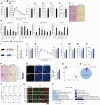Signaling through the nicotinic acetylcholine receptor in the liver protects against the development of metabolic dysfunction-associated steatohepatitis
- PMID: 39028754
- PMCID: PMC11290650
- DOI: 10.1371/journal.pbio.3002728
Signaling through the nicotinic acetylcholine receptor in the liver protects against the development of metabolic dysfunction-associated steatohepatitis
Abstract
Metabolic dysfunction-associated steatohepatitis (MASH) is the progressive form of liver steatosis, the most common liver disease, and substantially increases the mortality rate. However, limited therapies are currently available to prevent MASH development. Identifying potential pharmacological treatments for the condition has been hampered by its heterogeneous and complex nature. Here, we identified a hepatic nonneuronal cholinergic signaling pathway required for metabolic adaptation to caloric overload. We found that cholinergic receptor nicotinic alpha 2 subunit (CHRNA2) is highly expressed in hepatocytes of mice and humans. Further, CHRNA2 is activated by a subpopulation of local acetylcholine-producing macrophages during MASH development. The activation of CHRNA2 coordinates defensive programs against a broad spectrum of MASH-related pathogenesis, including steatosis, inflammation, and fibrosis. Hepatocyte-specific loss of CHRNA2 signaling accelerates the disease onset in different MASH mouse models. Activation of this pathway via pharmacological inhibition of acetylcholine degradation protects against MASH development. Our study uncovers a hepatic nicotinic cholinergic receptor pathway that constitutes a cell-autonomous self-defense route against prolonged metabolic stress and holds therapeutic potential for combatting human MASH.
Copyright: © 2024 Jun et al. This is an open access article distributed under the terms of the Creative Commons Attribution License, which permits unrestricted use, distribution, and reproduction in any medium, provided the original author and source are credited.
Conflict of interest statement
The authors declare no competing interests.
Figures




References
-
- Mantovani A, Petracca G, Beatrice G, Csermely A, Lonardo A, Targher G. Glucagon-Like Peptide-1 Receptor Agonists for Treatment of Nonalcoholic Fatty Liver Disease and Nonalcoholic Steatohepatitis: An Updated Meta-Analysis of Randomized Controlled Trials. Meta. 2021;11(2). Epub 2021/01/31. doi: 10.3390/metabo11020073 ; PubMed Central PMCID: PMC7911747. - DOI - PMC - PubMed
MeSH terms
Substances
Grants and funding
LinkOut - more resources
Full Text Sources
Molecular Biology Databases

